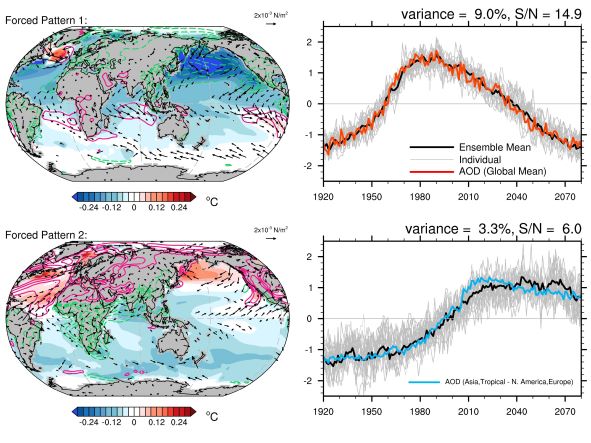Shi, J.-R., Kwon, Y.-O., & Wijffels, S. E., 2022. Two Distinct Modes of Climate Responses to the Anthropogenic Aerosol Forcing Changes. Journal of Climate, 1–27. https://doi.org/10.1175/jcli-d-21-0656.1
Anthropogenic aerosols (AAs) have a heterogeneous spatial and temporal distribution, which can induce regional responses that are distinct from those driven by greenhouse gases and those associated with internal variability. In this study, we use a signal-to-noise-maximizing pattern recognition method to isolate the forced climate response to anthropogenic aerosols from that of internal variability from 1920 to 2080.
We find that the aerosol forced responses of various fields (SST, salinity, precipitation, sea surface height, etc.) are dominated by two components: one is associated with the historical increase and future decrease of global (or Northern Hemisphere, NH) mean aerosol concentrations; the other is due to the transition of anthropogenic aerosols emissions from the West to the East and also from NH extratropics to lower latitudes. The global mean effect gives rise to a dominant NH cooling (warming) and a southward (northward) ITCZ shift during the historical period (future projection). The AA transition effect leads to a warming in the NH extratropical regions and a cooling in the Indo-Pacific and Southern Ocean, which to some extent compensates for the hemispheric asymmetry due to the global mean effect in the historical period. Moreover, the aerosol transition effect generates a zonal asymmetry in surface salinity response: a freshening in the North Atlantic and a salinity increase in the Indo-Pacific. Importantly, this study shows that the AA-driven trends during recent decades, e.g. 1967-2007, are dominated by the aerosol transition effect rather than its global (or NH) mean effect.

